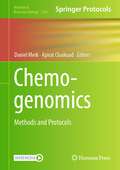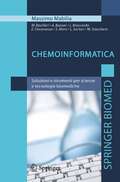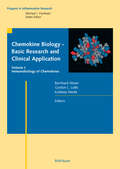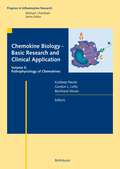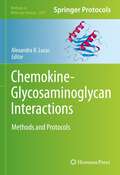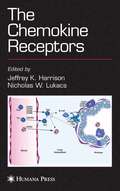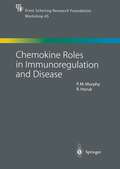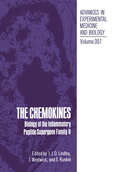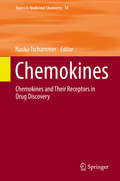- Table View
- List View
Chemogenomics: Methods and Protocols (Methods in Molecular Biology #2706)
by Daniel Merk Apirat ChaikuadThis volume presents both theoretical guidance and protocols on chemogenomics including chemogenomics library assembly, compound profiling, and phenotypic assays. The chapters in this book cover topics such as the assembly and use of Kinase Chemogenomics; data mining for chemogenomic compound candidates; protocols for protein family-focused assay systems to profile chemogenomic compounds; functional and target engagement assays in cellular settings for broad characterization; and a discussion on phenotypic assays where chemogenomic sets may be applied. Written in the highly successful Methods in Molecular Biology series format, chapters include introductions to their respective topics, lists of the necessary materials and reagents, step-by-step, readily reproducible laboratory protocols, and tips on troubleshooting and avoiding known pitfalls.Cutting-edge and thorough, Chemogenomics: Methods and Protocols is a valuable resource for all researchers who are interested in learning more about this diverse and developing field.
Chemoinformatica: Soluzioni e strumenti per scienze e tecnologie biomediche
by Massimo MabiliaChemoinformatica”, o informatica chimica, si riferisce all’uso di “metodi informatici per risolvere problemi chimici”: ha come oggetto ”strutture molecolari” e descrizioni, proprietà e dati ad esse collegate. Grazie a questo volume, pensato e scritto per docenti, studenti e professionisti che desiderino arricchire le proprie conoscenze in una o più aree di applicazione della “Chemoinformatica”, termini, sigle e acronimi come DOE, virtual docking and screening, QSAR, structure-based design, ADMET predictions e molti altri, non saranno più velati da un’ombra di mistero e diventeranno accessibili. Senza bisogno di prerequisiti né di competenze o esperienze specifiche, al lettore è offerta, da una parte, una panoramica adeguatamente ampia del settore “Chemoinformatico” e, dall’altra, sufficienti informazioni utili nella eventualità che desideri approfondire specifici argomenti di interesse incontrati nel volume. Agli inizi degli anni ’80 del secolo scorso la grafica molecolare iniziava a diffondersi; il “computer-aided drug design” veniva utilizzato dalle prime aziende farmaceutiche negli USA ed era ancora perlopiù sconosciuto in Italia; la “Chemoinformatica” non esisteva nemmeno come termine; internet era di là a venire: esisteva in germe come rete di comunicazione gestita dal Dipartimento della Difesa statunitense. Dai calcolatori di seconda generazione che non utilizzavano i transistor ma ancora le schede perforate, a quelli di terza generazione caratterizzati dall’avvento del terminale, ai “portatili” di oggi, dai primi centri di calcolo a quelli di super-calcolo, al “grid computing” e “cloud computing” di oggi, la gamma delle soluzioni software e la complessità dei calcoli, delle simulazioni e delle ricerche in database ora possibili, sono aumentate in modo entusiasmante nel settore della “Chemoinformatica”. Sempre più dati – sperimentali, virtuali, testuali, numerici, chimico-strutturali, chimico-fisici, analitici, spettrali, biologici, farmacologici, biomedici, etc. – vengono generati, e aumenta così la necessità di archiviarli, ricercarli, renderli facilmente fruibili, per trasformare i dati in informazione e l’informazione in conoscenza.
Chemoinformatics: Concepts, Methods, and Tools for Drug Discovery (Methods in Molecular Biology #275)
by Jürgen BajorathIn the literature, several terms are used synonymously to name the topic of this book: chem-, chemi-, or chemo-informatics. A widely recognized de- nition of this discipline is the one by Frank Brown from 1998 (1) who defined chemoinformatics as the combination of “all the information resources that a scientist needs to optimize the properties of a ligand to become a drug. ” In Brown’s definition, two aspects play a fundamentally important role: de- sion support by computational means and drug discovery, which distinguishes it from the term “chemical informatics” that was introduced at least ten years earlier and described as the application of information technology to ch- istry (not with a specific focus on drug discovery). In addition, there is of course “chemometrics,” which is generally understood as the application of statistical methods to chemical data and the derivation of relevant statistical models and descriptors (2). The pharmaceutical focus of many developments and efforts in this area—and the current popularity of gene-to-drug or si- lar paradigms—is further reflected by the recent introduction of such terms as “discovery informatics” (3), which takes into account that gaining kno- edge from chemical data alone is not sufficient to be ultimately successful in drug discovery. Such insights are well in accord with other views that the boundaries between bio- and chemoinformatics are fluid and that these d- ciplines should be closely combined or merged to significantly impact b- technology or pharmaceutical research (4).
Chemokine Biology - Basic Research and Clinical Application: Vol. 1: Immunobiology of Chemokines (Progress in Inflammation Research)
by William W. Agace Marco Baggiolini Craig T. Morita Federica Sallusto José Miguel Rodriguez-Frade Paul Kubes Basil O. Gerber Joost J. Oppenheim Sergio Romagnani Grant McFadden Osamu YoshieChemokines play an important role in recruiting inflammatory cells into tissues in response to infection and inflammation. They also play an important role in coordinating the movement of T-cells, B-cells and dentritic cells, necessary to generate an immune response (response to injury, allergens, antigens, invading microorganisms). They selectively attract leukocytes to inflammatory foci, inducing both cell migration and activation. They are involved in various diseases, like atherosclerosis, lung and skin inflammation, multiple sclerosis, or HIV.Volume 1 of this two-volume set discusses the immunobiology of chemokines. It is divided into two parts: a) cellular targets in innate and adaptive immunity, and b) effector cell traffic-unrelated functions. Together with volume 2, which discusses the pathophysiology of chemokines, both volumes give a comprehensive overview of chemokine biology.
Chemokine Biology - Basic Research and Clinical Application: Vol. 2: Pathophysiology of Chemokines (Progress in Inflammation Research)
by Kuldeep Neote L. Gordon Letts Bernhard MoserChemokines play an important role in recruiting inflammatory cells into tissues in response to infection and inflammation. They also play an important role in coordinating the movement of T-cells, B-cells and dentritic cells, necessary to generate an immune response (response to injury, allergens, antigens, invading microorganisms). They selectively attract leukocytes to inflammatory foci, inducing both cell migration and activation. They are involved in various diseases, like atherosclerosis, lung and skin inflammation, multiple sclerosis, or HIV. Volume 2 of this two-volume set discusses the pathophysiology of chemokines. It is divided into two parts: a) chemokines in animal disease models, and b) chemokines as drug targets. Together with volume 1, which discusses the immunobiology of chemokines, both volumes give a comprehensive overview of chemokine biology.
Chemokine-Glycosaminoglycan Interactions: Methods and Protocols (Methods in Molecular Biology #2597)
by Alexandra R. LucasThis detailed volume provides methods to guide assay development, procedures designed to investigate the chemokine and glycosaminoglycan (GAG) networks, as well as their interactions, in a wide range of organs and tissues in disease and in health. The initial chapters in this book present in vivo models used to examine the roles of chemokines and GAGs in normal physiology and in the pathophysiology of disease. The book then explores present cell- and tissue-based in vitro assays to examine chemokine:GAG interactions. Finally, analytic approaches are presented that provide assays for measuring GAGs, chemokines, and cellular responses. Written for the highly successful Methods in Molecular Biology series, chapters include introductions to their respective topics, lists of the necessary materials and reagents, step-by-step and readily reproducible laboratory protocols, and tips on troubleshooting and avoiding known pitfalls. Authoritative and practical, Chemokine-Glycosaminoglycan Interactions: Methods and Protocols serves as an ideal guide for researchers seeking to analyze chemokine and GAG functions, interactions, and molecular mechanisms in vivo and in vitro.
Chemokine Protocols (Methods in Molecular Biology #138)
by Amanda E. I. Proudfoot, Timothy N. C. Wells and Christine A. PowerThe chemokines family of small proteins are involved in numerous b- logical processes ranging from hematopoiesis, angiogenesis, and basal l- kocyte trafficking to the extravasation and tissue infiltration of leukocytes in response to inflammatory agents, tissue damage, and bacterial or viral infection. Chemokines exert their effects through a family of seven G-protein coupled transmembrane receptors. Worldwide interest in the chemokine field surged dramatically early in 1996, with the finding that certain chemokine receptors were the elusive coreceptors, required along with CD4, for HIV infection. Today, though over 40 human chemokines have been described, the n- ber of chemokine receptors lags behind—only 17 human chemokine receptors have been identified so far. What has emerged over the years is that most chemokine receptors bind several distinct ligands, and indeed the majority of chemokines are able to bind to multiple chemokine receptors, explaining to some extent the apparent disparity in the numbers of chemokines and rec- tors. Yet in spite of the apparent redundancy in chemokine/chemokine rec- tor interactions, it is clear that in vivo, spatial, temporal, and indeed cell- and tissue-specific expression of both chemokines and their receptors are imp- tant factors in determining the precise nature of cellular infiltrates in phy- ological and pathological processes.
The Chemokine Receptors (The Receptors)
by Jeffrey K. Harrison Nicholas W. LukacsThis volume, new to The Receptors series, focuses on several areas, including the birth, maturation, and structure of Chemokines; Neutrophil, Dendritic, and Lymphocyte trafficking; and Chemokine Receptors in diseases such as AIDs and lung cancer. In particular the book contains cutting-edge information ranging from basic molecular and cellular mechanisms to physiological and pathological roles of chemokines.
Chemokine Receptors and NeuroAIDS: Beyond Co-Receptor Function and Links to Other Neuropathologies
by Olimpia MeucciChemokine Receptors and NeuroAIDS: Beyond the Co-receptor Function and Links to Other Neuropathologies focuses on unresolved or emerging issues concerning the role of chemokine receptors in neuronal injury and HIV neuropathology, including their ability to regulate fundamental neuronal and glial functions and their role in neurovirulence and neurotoxicity. Although the importance of these molecules in the CNS physiology and pathology is now apparent, these issues are still matter of debate, and further research is required to design effective pharmacological agents that specifically target the brain chemokine system without major side effects. To this end, specific topics have been selected and are reviewed by international experts within the basic science/medical community. This book encourages investigation in the most controversial areas and fosters interaction between clinicians and basic scientists. The book also increases awareness about differences in disease progression among different parts of the world as well as selected patient populations, which may also help identifying novel therapeutic strategies.
Chemokine Receptors as Drug Targets (Methods and Principles in Medicinal Chemistry #46)
by Raimund Mannhold Hugo Kubinyi Gerd FolkersChemokines are hormone-like signaling molecules secreted by cells to signal infection and guide the immune response. Following a decade of basic chemokine research, the pharmaceutical industry has now begun to exploit this crucial signaling pathway for the development of innovative drugs against AIDS, cancer, neural and autoimmune diseases. Here is the first reference focusing on these novel drug development opportunities. Opening with a general introduction on chemokine function and chemokine receptor biology, the second part covers the known implications of these signaling molecules in human diseases, such as cancer, neural disorders, and viral infection, including AIDS. The third part systematically surveys current drug development efforts at targeting individual chemokine receptors, as well as other chemokine interaction partners, including up-to-date reports from the pharmaceutical industry.
Chemokine Receptors as Drug Targets (Methods and Principles in Medicinal Chemistry #46)
by Raimund Mannhold Hugo Kubinyi Gerd FolkersChemokines are hormone-like signaling molecules secreted by cells to signal infection and guide the immune response. Following a decade of basic chemokine research, the pharmaceutical industry has now begun to exploit this crucial signaling pathway for the development of innovative drugs against AIDS, cancer, neural and autoimmune diseases. Here is the first reference focusing on these novel drug development opportunities. Opening with a general introduction on chemokine function and chemokine receptor biology, the second part covers the known implications of these signaling molecules in human diseases, such as cancer, neural disorders, and viral infection, including AIDS. The third part systematically surveys current drug development efforts at targeting individual chemokine receptors, as well as other chemokine interaction partners, including up-to-date reports from the pharmaceutical industry.
Chemokine Receptors in Cancer (Cancer Drug Discovery and Development)
by Amy M. FultonChemokines are a superfamily of low molecular weight cytokines that were initially described based on their ability to induce the directed migration of leukocytes to sites of inflammation or injury. In humans, there are approximately 45 chemokines that bind to 19 G-protein-coupled receptors. In addition to mediating cellular migration, chemokines have now been shown to affect many cellular functions including survival, adhesion, invasion, proliferation, and to regulate circulating chemokine levels. Although chemokine receptors were first described on leukocytes, it is now appreciated that chemokine receptors are also expressed by many other cells including endothelial and epithelial cells. Since the first description of chemokine receptors on malignant cells in 2001, an extensive literature has developed describing the expression and function of chemokine receptors in many malignancies. These studies support the initial hypothesis that malignant cells use chemokine receptors to migrate to distant sites of ligand expression and that expression of certain receptors is associated with a poor prognosis. It has also become apparent that malignancies of different tissues may use a diverse profile of chemokine receptors and that the same receptor may mediate metastasis to different sites in tumors of different histological origins. Receptor function may also maintain survival and expansion of the primary tumor.
Chemokine Roles in Immunoregulation and Disease (Ernst Schering Foundation Symposium Proceedings #45)
by P. M. Murphy, R. HorukThe Chemokine System in Experimental and Clinical Hematology (Current Topics in Microbiology and Immunology #341)
by Oystein BruserudThe aim of the issue is to describe and explain the importance of the chemokine system in hematology. The chemokine system is probably important for many aspects of normal as well as malignant hematopoiesis. A major focus is the development and treatment of hematologic malignancies, including the immunobiology of stem cell transplantation. The present reviews illustrate that chemokines can be involved in leukemogenesis. The chemokine system is also important both for the crosstalk between malignant cells and their neighbouring nonmalignant stromal cells (including endothelial cells) as well as for immunoregulation in patients treated with allogeneic stem cell transplantation. Thus, chemokines are important both for the pathogenesis and treatment of hematological diseases.
The Chemokines: Biology of the Inflammatory Peptide Supergene Family II (Advances in Experimental Medicine and Biology #351)
by I. J. D. Lindley J. Westwick S. KunkelThe first symposium in this series was held at the Royal College of Surgeons of England in December 1988 and was entitled "Novel Neutrophil Stimulating Peptides". That symposium successfully brought together the majority of laboratories working in the area of interleukin-8 and related peptides; see Immunology Today 10: 146-147 (1989). The Second International Symposium on Chemotactic Cytokines was held at the same venue in June 1990, and a much-increased attendance reflected the accelerating pace of work in the area of these chemotactic cytokines. The proceedings of that meeting were published in Advances in Experimental Medicine and Biology, vol. 305 (1991). The rapid advances made in the field of chemotactic cytokines over the last 18 months necessitated a third Symposium in this series to collate and place in perspective an explosion of new data. The Third International Symposium on Chemotactic Cytokines was held between August 31 and September 1, 1992 in Baden-bei-Wien, Austria. However, the lack of a clear nomenclature system was creating some confusion in the area, especially as new factors continue to be discovered and classified as family members. In the past, these inflammatory mediators had been placed arbitrarily under the broad heading of "intercrines" or "chemotactic cytokines" with no clear classification guidelines to follow. This nomenclature issue was addressed at the Symposium, where investigators in the field were invited to reach a consensus regarding a collective name for these mediators. The resulting decision was to identify the major family as chemokines, to replace all previous terms.
Chemokines: Chemokines and Their Receptors in Drug Discovery (Topics in Medicinal Chemistry #14)
by Nuska TschammerMedicinal chemistry is both science and art. The science of medicinal chemistry offers mankind one of its best hopes for improving the quality of life. The art of medicinal chemistry continues to challenge its practitioners with the need for both intuition and experience to discover new drugs. Hence sharing the experience of drug research is uniquely beneficial to the field of medicinal chemistry. Drug research requires interdisciplinary team-work at the interface between chemistry, biology and medicine. Therefore, the topic-related series Topics in Medicinal Chemistry covers all relevant aspects of drug research, e.g. pathobiochemistry of diseases, identification and validation of (emerging) drug targets, structural biology, drugability of targets, drug design approaches, chemogenomics, synthetic chemistry including combinatorial methods, bioorganic chemistry, natural compounds, high-throughput screening, pharmacological in vitro and in vivo investigations, drug-receptor interactions on the molecular level, structure-activity relationships, drug absorption, distribution, metabolism, elimination, toxicology and pharmacogenomics. In general, special volumes are edited by well known guest editors.
Chemokines and Cancer (Contemporary Cancer Research)
by Barrett J. RollinsChemokines and Cancer synthesizes a state-of-the-art understanding of the role that chemokines and their receptors play in the pathophysiology of malignancy. It examines the influence of chemokines on a broad array of malignant cells, including their effects on such intrinsic properties as growth and movement, as well as exploring their influence on the host's response to a growing tumor. The authors also demonstrate the physiological consequences of chemokine expression and suggest how chemokines can be used to regulate tumor growth in vivo, including their direct effects on tumor growth, on tumor destruction by host inflammatory cells, and on tumor angiogenesis. The only book available that relates chemokines to cancer, Chemokines and Cancer holds out the promise of novel therapeutic approaches to malignancy through the manipulation of chemokines and/or their receptors.
Chemokines and Viral Infection (Current Topics in Microbiology and Immunology #303)
by Thomas E. LaneChemokines represent a family of over 40 small proteins that, for the most part, are secreted into the environment and function by binding to G protein-coupled receptors (GPCRs) that are expressed on numerous different cell types. When initially identified close to 30 years ago, these molecules were associated with various human inflammatory diseases and it was recognized that expression may be integral in leukocyte recruitment to inflamed tissue. Within a relatively short period of time, early participants within the field determined that these proteins displayed distinct and conserved structural features and exerted potent chemotactic effects on defined lymphocyte subsets. There are now four sub-families of chemokines identified based on defined structural criteria relating to the positional location of conserved cysteine residues within the amino-terminus of the protein. Chemokines are now recognized as important in numerous biological processes ranging from maintaining the organizational integrity of secondary lymphoid tissue to participating in various aspects of both innate and adaptive immune responses following microbial infection.
Chemokines in Disease: Biology and Clinical Research (Contemporary Immunology)
by Caroline A. HébertCaroline Hébert and a panel of key experimentalists and clinical investigators comprehensively review the state-of-the-art in the chemokine field, ranging from the effects of chemokines and their receptors in retroviral infections, to their role in inflammation, angiogenesis/angiostasis, and tumor cell biology. The book examines in detail fifteen recently identified chemokines and elucidates the role of chemokine function in vivo from animal experiments. Animal models are also used to explore how chemokines operate in a variety of chronic and acute inflammatory diseases and in noninflammatory processes. A detailed review of the emerging role of chemokines in viral biology is also presented, with emphasis on HIV biology and novel therapeutic possibilities. Chemokines in Disease: Biology and Clinical Research summarizes the rapidly expanding knowledge of a dazzling array of chemokines and provides fresh insights into the development of powerful new drugs for treating a wide spectrum of diseases.
Chemometrics: Statistics and Computer Application in Analytical Chemistry
by Matthias OttoChemometrics Explore chemometrics from basic statistics to the latest artificial intelligence and neural network developments in this new edition Chemometrics is an area of study combining chemistry and mathematics. It governs the interpretation of data generated by chemical analysis, and its growth as a subfield promises to streamline and revolutionize analytical chemistry. Chemometrics has long been the leading introductory textbook in this subject. Beginning with an introduction to the statistical-mathematical evaluation of chemical measurements, it leads readers through modern chemometric approaches in a pedagogically sound and highly readable style. Now fully updated to reflect the latest research and applications of this exciting discipline, it provides essential tools for a new generation of analytical chemists. Readers of the fourth edition of Chemometrics will also find: New or expanded treatment of subjects such as deep learning, ANNOVA simultaneous component analysis, instrumental data output, and more Detailed discussion of approaches to signal processing, design and optimization of experiments, pattern recognition and classification, and many other areas Balance of theoretical and practical knowledge to enable rapid application of key techniques Chemometrics is ideal for advanced students in chemistry, analytical chemistry, pharmaceutical chemistry, biochemistry, or related subjects, and as a useful reference for practicing researchers and laboratory professionals.
Chemometrics: Statistics and Computer Application in Analytical Chemistry
by Matthias OttoChemometrics Explore chemometrics from basic statistics to the latest artificial intelligence and neural network developments in this new edition Chemometrics is an area of study combining chemistry and mathematics. It governs the interpretation of data generated by chemical analysis, and its growth as a subfield promises to streamline and revolutionize analytical chemistry. Chemometrics has long been the leading introductory textbook in this subject. Beginning with an introduction to the statistical-mathematical evaluation of chemical measurements, it leads readers through modern chemometric approaches in a pedagogically sound and highly readable style. Now fully updated to reflect the latest research and applications of this exciting discipline, it provides essential tools for a new generation of analytical chemists. Readers of the fourth edition of Chemometrics will also find: New or expanded treatment of subjects such as deep learning, ANNOVA simultaneous component analysis, instrumental data output, and more Detailed discussion of approaches to signal processing, design and optimization of experiments, pattern recognition and classification, and many other areas Balance of theoretical and practical knowledge to enable rapid application of key techniques Chemometrics is ideal for advanced students in chemistry, analytical chemistry, pharmaceutical chemistry, biochemistry, or related subjects, and as a useful reference for practicing researchers and laboratory professionals.
Chemometrics with R: Multivariate Data Analysis in the Natural and Life Sciences (Use R!)
by Ron WehrensThis book offers readers an accessible introduction to the world of multivariate statistics in the life sciences, providing a comprehensive description of the general data analysis paradigm, from exploratory analysis (principal component analysis, self-organizing maps and clustering) to modeling (classification, regression) and validation (including variable selection). It also includes a special section discussing several more specific topics in the area of chemometrics, such as outlier detection, and biomarker identification. The corresponding R code is provided for all the examples in the book; and scripts, functions and data are available in a separate R package. This second revised edition features not only updates on many of the topics covered, but also several sections of new material (e.g., on handling missing values in PCA, multivariate process monitoring and batch correction).
Chemometrics with R: Multivariate Data Analysis in the Natural Sciences and Life Sciences (Use R!)
by Ron Wehrens"Chemometrics with R" offers readers an accessible introduction to the world of multivariate statistics in the life sciences, providing a complete description of the general data analysis paradigm, from exploratory analysis to modeling to validation. Several more specific topics from the area of chemometrics are included in a special section. The corresponding R code is provided for all the examples in the book; scripts, functions and data are available in a separate, publicly available R package. For researchers working in the life sciences, the book can also serve as an easy-to-use primer on R.
Chemoprevention of Cancer: A Clinical Update (Recent Results in Cancer Research #151)
by V. CraigJordan AlbertoCosta Hans-JörgSennPharmacologic interventions to prevent the evolution of human cancers are still in its infancy, although a good number o- mostly controlled - clinical studies have been performed in the past two decades. However, regarding the partially stagnating therapeutic results of major epithelial cancer types such as breast-, lung-, colon- and ENT-cancer types, the problem of in terference with the evolution of disease at a preclinical level is an intriguing one, and the field seems to develop into one of the fastest growing domaines of modern oncology. This process is fa cilitated by the developments of molecular on co-genetics and the gowing existence of family cancer units, allowing to better identi fy and inform respective high risk groups, thus enabling re searchers and clinicians to more realistically target their chemo preventive efforts to the true populations at risk. On this changing background, the newly formed International Society of Cancer Chemoprevention (ISCaC) together with the Swiss Cancer League and the Interdisciplinary Oncology Center of St. Gallen/Switzerland organized an international Symposium in September 1997, inviting basic researchers, epidemiologists and clinical oncologists of related disciplines to discuss pertinent issues of experimental and clinical chemo- and bio-prevention in a scientific workshop.
